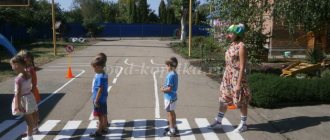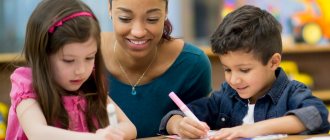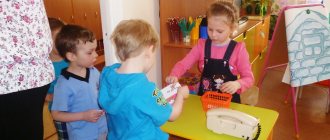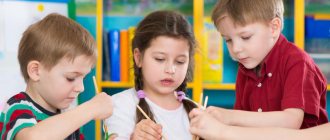Games for the socialization of preschool children of the preparatory group
Speech at the pedagogical council: “Games and exercises that increase the level of social competence of older preschoolers”
“Game is important in a child’s life... What a child is like at play, so in many ways he will be at work when he grows up. Therefore, the education of a future leader occurs, first of all, in the game...” A.S. Makarenko Goal: to promote the development and subsequent active use of modern gaming technologies in the practical activities of the teacher. Objectives: • Contribute to the improvement of the educational process to expand and clarify ideas about play as an important factor in a child’s life. • Encourage teachers to actively interact in joint games and exercises. • Create conditions for relieving tension of participants, developing communication skills and creativity. Participants: educators. Today we live in a very difficult world. Life puts us in difficult situations that require adequate solutions. Only a person who is confident in himself and in his capabilities can achieve high results, develop creative abilities and actively express himself. Socialization that is not formed in older preschool age leads to low academic performance, aggressiveness, and the use of physical force. It is in preschool age that the foundations of a child’s social competence are laid, determining the trajectories of development and successful adaptation in a changing society. Gaming activities occupy a special place in the process of developing the social competence of the younger generation. The influence of play on the formation of social competence skills of a preschooler’s personality lies in the fact that, thanks to playful imitation and role-playing, he becomes acquainted with the norms and models of behavior and relationships between children and adults, which become models for his own behavior. In play, the child acquires the basic skills of social competence necessary to establish contact and develop interaction with the outside world. In pedagogical practice, gaming activities perform the following functions: • Entertaining – entertains, uplifts, gives pleasure, inspires, arouses interest; • Communicative – promotes communication; • Self-realization – gives a person the opportunity to express himself; • Game therapy – helps to overcome various difficulties that arise in life; • Diagnostic – allows you to identify deviations in development and behavior, self-knowledge during the game; • Corrective – allows you to make positive changes in the personality structure; • Interethnic communication – allows you to assimilate socio-cultural values that are common to all people; • Socialization – makes it possible to include a person in the system of social relations and contributes to his assimilation of social norms. It also helps adapt the child to environmental conditions, helps fight stress, promotes self-regulation, and teaches communication. Today I would like to share with you techniques, games and exercises that you can use in the future with children in order to maintain and strengthen their psychological health and increase their level of social competence. The game situations that I will introduce to you today encourage children to draw closer to each other and to the teacher on the basis of empathy for both the situation itself and its participants, and not only for those events that require sympathy and participation, but also for joyful, cheerful events. The purpose of the techniques and exercises is to create a sense of belonging to a peer group. The content of the exercises is aimed at attracting attention to the partner, his appearance, mood, actions, deeds; The main method is direct interaction. All this expands our understanding of ourselves, those around us, and our actions, and thereby increases the level of social competence of our children. In order not to waste too much time, I suggest that you immediately begin the practical part of our mini-training and first become good wizards. Game “Good Wizards” Teachers stand in a circle. The presenter tells a fairy tale: “In one country there lived an evil wizard - a rude man. He could bewitch you by calling you a bad word. Everyone he called rudely stopped laughing and could not be kind. It was possible to disenchant the unfortunate man only with kind, affectionate names. Let's disenchant everyone (they call each other by affectionate good names). • In what cases can this game be used? (to raise the mood of children, after a quarrel, to a certain topic of kindness, mutual assistance, etc.). • What does it teach? (communication, the ability to be kinder, more polite, help each other). Exercise “Name-calling” (ball) Purpose:
to remove verbal aggression, to help children throw out anger in an acceptable form.
Tell the children the following: “Guys, passing the ball around, let’s call each other different harmless words (the condition of what names can be used is discussed in advance. These can be the names of vegetables, fruits, mushrooms or furniture). Each appeal should begin with the words: “And you, ..., carrot!” Remember that this is a game, so we won’t be offended at each other. In the final circle, you should definitely say something nice to your neighbor, for example: “And you, .... Sun!" The game is useful not only for aggressive, but also for touchy children. It should be carried out at a fast pace, warning the children that this is only a game and they should not be offended by each other. Exercise “Lost Girl” Purpose:
to promote the development of self-esteem in children.
The children sit in a circle, the presenter “makes an announcement on the radio”: “Attention, attention, a girl (boy) is lost...” - and then describes the appearance and clothing of one of the children. Anyone who recognizes himself needs to shout loudly: “I found myself (found myself), I came to see you in kindergarten (came).” Next, I will talk about ways that will help you calm down a very active, naughty child, involving him in play activities, setting him up for constructive behavior: If the child runs around non-stop, screams in a voice that is not his own, rolls on the floor, makes chaotic movements with his arms and legs and completely If he doesn’t hear what you say to him, catch him, hug him and in a quiet voice invite him to play. 1. Agree with your baby that as soon as you press on his nose, he will immediately turn off. You can expand on this idea by drawing a remote control (or use an unwanted TV remote). Press the button on the remote control and say: turn down the volume (turn off the sound, turn on slowdown). Let the child follow the commands. 2. Invite your child to imagine himself as a whale. Let him take a deep breath and dive into the depths. The whale can be given instructions to swim to different continents or look for something at the bottom. 3. Ask your child to close his eyes and sit still, waiting for a certain signal. For example, when the bell rings for the third time. Or ask your child to do something with his eyes closed (put the car on the table, collect cubes from the floor). 4. Take a napkin (or a piece of wood) and throw it up. Tell your child that while the napkin is falling, you need to laugh as loudly as possible. But as soon as it falls, you should immediately shut up. Play together with your child. Exercise “I can!” (ball) Purpose:
to promote the development of self-esteem in children.
Children throw a ball around and loudly list what they can do well. For example: “I can swim well!”, “I can draw well!”, etc. “The Steadfast Tin Soldier” technique Goal:
relieving psycho-emotional stress, developing the ability to understand one’s emotional state and the ability to express it.
Tell your child: “When you are very excited and cannot stop, pull yourself together, stand on one leg and bend the other at the knee, lower your arms at your sides. You are a staunch soldier at your post, you carry out your service honestly, look around, notice what is happening around you, who is doing what, who needs help. Now change your leg and look even more closely. Well done! You are a real protector! Technique “Pull yourself together” Purpose:
relieving psychophysical stress.
The child is told: “As soon as you feel that you are worried, you want to hit someone, throw something, there is a very simple way to prove your strength to yourself: clasp your elbows with your palms and press your hands tightly to your chest - this is the pose of a self-possessed person.” Game “Naughty Pillows” (pillow) Purpose:
to provide the child with the opportunity to “legally” display disobedience.
An adult tells the children that naughty pillows have appeared in their study room. When you throw them at each other, they say “naughty” words, for example: “I don’t want to study... I won’t eat...”, etc. Then the presenter invites the children to play with such pillows. The game takes place as follows: a couple plays - an adult and a child, the rest watch what is happening. All the children take turns playing. It is very important that “naughty” words are spoken not only by the child, but also by the adult. Exercise “Picture” (picture) I invite 5 participants for the next exercise. Four go out the door, one stays and receives the task: “You are in an art gallery, and you liked one painting very much, you have a minute to look at it, then you tell your friend what you saw. Pay attention to the foreground, the background, etc.” After a minute, the picture is removed. The second participant comes in and the first begins his story with the words: “Yesterday I was in an art gallery and saw there - ....” The second one tries to carefully remember the information and pass it on to the third: “My friend was in an art gallery yesterday, and saw there - ...”, and so on until the end. The last participant sums it up: “A friend of a friend was in an art gallery and saw there:...”. After this, the picture is shown to those who have not seen it. Please share your observations and difficulties encountered during the exercise. What do you think this exercise teaches, what develops? Develops attention, auditory and visual memory, observation, speech, teaches interpersonal interaction, communication ethics (transferring someone else’s words to another, thinking through, inventing any words or actions for another in psychology is called “causal attribution.” We must teach cultural interaction and attentive towards each other. Please stay, participants in this exercise for a short game. Game “Tuh-Tibi-Duh” “I’ll tell you a secret special word. This is a magic spell against bad mood, against insults and disappointments... Now you will begin to walk around room, without talking to anyone. As soon as you want to talk, stop in front of one of the participants, look into his eyes and three times, angrily, say the magic word: “Tuh-tibi-duh.” Then continue walking around the room. From time to time time, stop in front of someone and again angrily and angrily pronounce this magic word. For the magic word to work, you need to say it not into emptiness, but looking into the eyes of the person standing in front of you. There is a comical paradox in this game. Although children are supposed to say the word "Tuh-tibi-duh" angrily, after a while they can't help but laugh. Goal:
removing negative moods and restoring strength. Dear colleagues, in fact, there are a lot of games and exercises for the development of social competence. And you can familiarize yourself with them in the collection that I compiled for you. You can borrow it from me and use it, watch it, read it, get recommendations for a particular game or exercise. Do you have any questions for me? I hope you enjoyed the mini-training. If yes, you can nod. Thank you for participating!
We recommend watching:
Methodological development on fairy tale therapy Socialization of children of senior preschool age through theatrical games Pedagogical work on the socialization and moral education of preschool children in accordance with the Federal State Educational Standard Contact and play improvisation with Velcro mittens for preschool children
Similar articles:
Psychological games for preschool children
Psychological games for preschoolers
Lesson notes for preschoolers. Traveling in a time machine
Psychological games for children 3-6 years old




